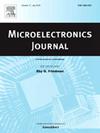A lightweight dual-link accelerated authentication protocol based on NLFSR-XOR APUF
IF 1.9
3区 工程技术
Q3 ENGINEERING, ELECTRICAL & ELECTRONIC
引用次数: 0
Abstract
Physical Unclonable Function (PUF) circuits, as a lightweight hardware security primitive, can provide reliable authentication for resource-constrained Internet of Things (IoT) devices. However, in real-time environments and systems, authentication of embedded devices has strict requirements on resources and low latency. Therefore, this paper proposes a lightweight dual-link accelerated authentication protocol design based on NLFSR-XOR APUF, through the study of Non-Linear Feedback Shift Registers (NLFSR) and XOR APUF circuits. First, the scheme utilizes the symmetric path delay deviation characteristics of APUF and the complexity of NLFSR state transitions to form a nonlinear output function that changes with the challenge signal. Then, a lightweight and attack-resistant authentication protocol is established by combining the random probability of shuffling array bits with the XOR confusion mechanism. Finally, the advantages of GPU parallel computing and AES T-table reconfiguration scheme are used to achieve an accelerated and side-channel attack-resistant authentication protocol. Experimental results show that the PUF circuit can effectively resist various modeling attacks, including logistic regression (LR), artificial neural network (ANN), and support vector machine (SVM). The security of the protocol has been formally verified, and the prototype has been implemented on the Xilinx xc100T development board, effectively resisting deception attacks, physical attacks, and modeling attacks. The protocol's area overhead in terms of LUT and encryption time is reduced by 58.6 % and 67.8 %, respectively, compared to similar protocols.
基于 NLFSR-XOR APUF 的轻量级双链路加速认证协议
物理不可克隆函数(PUF)电路作为一种轻量级硬件安全基元,可为资源受限的物联网(IoT)设备提供可靠的身份验证。然而,在实时环境和系统中,嵌入式设备的身份验证对资源和低延迟有着严格的要求。因此,本文通过对非线性反馈移位寄存器(NLFSR)和 XOR APUF 电路的研究,提出了一种基于 NLFSR-XOR APUF 的轻量级双链路加速认证协议设计。首先,该方案利用 APUF 的对称路径延迟偏差特性和 NLFSR 状态转换的复杂性,形成一个随挑战信号变化的非线性输出函数。然后,通过将阵列位的随机洗牌概率与 XOR 混淆机制相结合,建立了一种轻量级的抗攻击认证协议。最后,利用 GPU 并行计算和 AES T 表重新配置方案的优势,实现了一种加速的抗侧信道攻击认证协议。实验结果表明,PUF 电路能有效抵御各种建模攻击,包括逻辑回归(LR)、人工神经网络(ANN)和支持向量机(SVM)。该协议的安全性已得到正式验证,原型已在 Xilinx xc100T 开发板上实现,可有效抵御欺骗攻击、物理攻击和建模攻击。与同类协议相比,该协议在 LUT 和加密时间方面的面积开销分别减少了 58.6% 和 67.8%。
本文章由计算机程序翻译,如有差异,请以英文原文为准。
求助全文
约1分钟内获得全文
求助全文
来源期刊

Microelectronics Journal
工程技术-工程:电子与电气
CiteScore
4.00
自引率
27.30%
发文量
222
审稿时长
43 days
期刊介绍:
Published since 1969, the Microelectronics Journal is an international forum for the dissemination of research and applications of microelectronic systems, circuits, and emerging technologies. Papers published in the Microelectronics Journal have undergone peer review to ensure originality, relevance, and timeliness. The journal thus provides a worldwide, regular, and comprehensive update on microelectronic circuits and systems.
The Microelectronics Journal invites papers describing significant research and applications in all of the areas listed below. Comprehensive review/survey papers covering recent developments will also be considered. The Microelectronics Journal covers circuits and systems. This topic includes but is not limited to: Analog, digital, mixed, and RF circuits and related design methodologies; Logic, architectural, and system level synthesis; Testing, design for testability, built-in self-test; Area, power, and thermal analysis and design; Mixed-domain simulation and design; Embedded systems; Non-von Neumann computing and related technologies and circuits; Design and test of high complexity systems integration; SoC, NoC, SIP, and NIP design and test; 3-D integration design and analysis; Emerging device technologies and circuits, such as FinFETs, SETs, spintronics, SFQ, MTJ, etc.
Application aspects such as signal and image processing including circuits for cryptography, sensors, and actuators including sensor networks, reliability and quality issues, and economic models are also welcome.
 求助内容:
求助内容: 应助结果提醒方式:
应助结果提醒方式:


